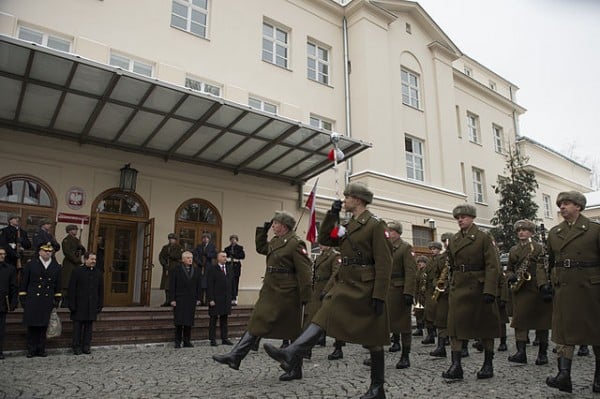
DOD photo by U.S. Marine Corps Sgt. Aaron Hostutler
In terms of security policy, 2014 was unique for Europe. The Russian-Ukrainian conflict has once again altered the fate of European security as the forgotten notion of war was restored into the political discourse. The entire European security architecture has trembled as the eastern flank of the continent has been destabilized. In fact, Russia has confirmed its predictable status of a revisionist power. In this context, a new priority setting in security policy was a necessity.
From a Polish perspective, the NATO summit in Wales correctly addressed a new security reality. The Alliance has started to refocus on its core mission and the decision to strategically enhance its eastern flank was reached. Currently, a full, swift and firm implementation of the NATO summit conclusions, especially the Readiness Action Plan, remains a priority.
However, on the NATO’s road from Wales to Warsaw (where the next meeting of the heads of state and government takes place in 2016) there is a strategic stopover in Brussels – June 2015 European Council – which will be dedicated to defense. The Russian-Ukrainian conflict has considerably affected the Common Security and Defence Policy (CSDP) highlighting its already diagnosed shortfalls and limitations. As underlined in the new Polish National Security Strategy, adopted on November 5, 2014, “further evolution of the CSDP depends on the progress of integration processes within the EU, intensification of collaboration between the EU and NATO, political will to build defence capabilities, and active operational involvement of the EU in its neighbourhood.”
The current geopolitical turbulence in Eastern Europe offers a chance to set the priorities right and to anchor the CSDP in a broader set of instruments which could help to confront the Russian challenge to a rules-based order. Four recommendations for Europeans come to the fore:
1) Improve cooperation with NATO. Both organizations should search for additional synergies as they have no interest in accommodating a revisionist power in their eastern neighborhood. Moreover, both the EU and NATO should aim at orchestrating their response to Russian “hybrid warfare,” being a combination of military and non-military, conventional and irregular components. An enhanced strategic communications, coordinated exercises and prioritizing of cybersecurity could constitute a starting point.
2) Renew financial commitment to defense. The world will neither be safer nor more just if Europe disarms. On the contrary, future generations of European citizens would likely face an international environment less amenable to both their socio-economic and security needs. Therefore, the EU should not exclude a creation of a defense pledge on its own. In fact, it could be based on an innovative formula going beyond a single indicator based on a GDP target.
3) Remain operationally engaged. Missions and operations are a powerhouse of the CSDP. EU should continue to focus its security efforts on its neighborhood, yet, rebalance the operational presence and boost its engagement in Eastern Europe. Moreover, a security sector reform could evolve into a trademark EU contribution. The EU Advisory Mission for Civilian Security Sector Reform in Ukraine (EUAM Ukraine) is a perfect example how to effectively use a comparative advantage of the CSDP toolbox.
4) Finalize the development of an inclusive defense sector. The Russian-Ukrainian conflict proves that as much as ever Europe needs a competitive and robust defense sector that will provide for European needs without any disturbance in times of crisis. Yet, any initiatives aiming at strengthening the European defense sector should take into account not only economic, but foremost security factors. In such circumstances, preserving the sovereign right to protect security interests by applying Article 346 of the Treaty on the Functioning of the EU remains a priority. Moreover, bearing in mind the differences between military potentials in Europe, Poland supports inclusivity, balance and fair participation of all member states and relevant parties in the restructuring of the European defense sector. In addition, Poland currently considers joining the Letter of Intent Framework Agreement Treaty which was signed in 2000 by six countries (France, Germany, Italy, Spain, Sweden and the UK) to create the necessary measures to facilitate the restructuring of the European defense industry.
How can the CSDP be best described in 2015 from a Polish perspective? Many policy wonks prefer Twitter over Facebook as it offers a tailored tool to engage in the heated social media debates. It seems to be faster and more acute. On the other hand, Facebook provides its users with more options and does not limit the posts to 140 signs. If NATO can be compared to Twitter than the CSDP can be best depicted as one of the Facebook functions. From a diplomatic perspective, both tools are essential and play a complementary role.
This article was originally published by European Geostrategy.
The opinions, findings and conclusions expressed herein are those of the author and do not necessarily reflect those of the Ministry of Foreign Affairs of the Republic of Poland.